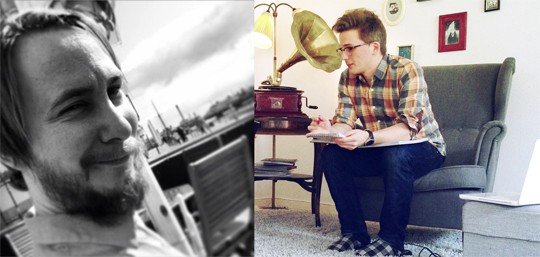
Can you give us a bit of background about yourselves and Simogo?
Simon Flesser: Me and Magnus ‘Gordon’ Gardebäck started Simogo in 2010 after having worked for about three years at the same game studio. The ambition was to make small games with a lot of character and personality. Gordon is the programmer, and I do art and sound, sometimes music – not for DEVICE 6 though, that excellent soundtrack was composed by Daniel Olsén. I would hardly call myself a writer, though!
Jonas Tarestad: I’ve liked storytelling since an early age. I used to write a lot as a child until I was about 15 and then – like many others – I drifted away from it. It was not until I started as an intern at a movie production company in my mid-20s that I returned to writing. I read loads of scripts and it did not take long until I started to write. Simon is one of my oldest friends and we talked about doing a project together for quite some time. About 18 months ago I sent Simon a short film script, just to get some feedback, and we ended up adapting it into the iOS game Year Walk.
Simon: The main concept was to explore the possibilites of mixing together maps and text to create something new. Then we slowly started to build a story around that concept, and create a universe and story in which that concept was deeply tied to the narrative.
Interactivity crossed with reading – it’s a tough gap to bridge. What’s the secret that makes Device 6 both readable and playable?
Simon: I think the key was finding a balance in what we communicated with the layout and the pictures, versus what we communicated via words. Perhaps you noticed that almost all of the text revolves around movement. Most of the time it just describes how Anna traverses this strange world. It’s very deliberately sparse in its descriptions, because of that. That’s why I think taking a regular novella and ‘translating’ it to this form would be near impossible.
It’s a little bit creepy, very surreal, and has dark touches here and there. How, as writers, did you generate the atmosphere?
Jonas: I’d say gut feeling is the most important aspect when writing suspenseful or creepy sequences. What scares you is bound to scare someone else. We talked a lot about what we thought was unsettling or just plain weird and then we tried to incorporate those elements into the story. There was a lot of experimenting in the early stages and many darlings were killed. And of course, all the graphics, sound and music heighten the surreal and creepy vibe. The sequence I find the most disturbing in the finished game never struck me as especially creepy when writing it. Oh, and listening to weird music while writing really helps.
Simon: Yeah I think Daniel Olsén’s music really elevates that feeling. One of the things Jonas and I discussed and almost used like a motto was to always do the unexpected. The player is never sure what’s around the corner. So we plotted the story out as a journey, and our conversions would sound like this:
“OK, how do she get out of there?”
“Through the… cabinet?”
“Sold!”
Did you play a role in the layout of Device 6, like how it scrolls off screen, turns corners and even goes down in a lift?
Simon: Yes, I designed all the layouts. We started with the concept of six chapters, and placed them in confined places on the island. I drew a rough map of the island, and a more detailed one for every single chapter. Basically, I just tried to match the layout to these maps as closely as I could. So when Anna turns, say, left, the direction might not be left on the screen, but the actual compass direction she faces at that moment. So when the iPhone is held in its starting position at the beginning of each chapter, up is always north.
You’re in Sweden and we love Scandinavian crime fiction – tell us about a few of the crime and mystery authors that have influence you and why you like them?
Jonas: I read all of the Sherlock Holmes books as a kid and I’ve re-read them many times since. I think they have had a huge influence on me when it comes to creating atmosphere. Foggy moors still work very well. Ten years ago I was into bleak and gritty stories, now I like bleak and cosy ones. Agatha Christie’s And Then There Were None is another favorite. It’s surprisingly scary and it is definitely one of the sources of inspiration for Device 6. I also read a lot of antiquated true crime books. I know a bit too much about murders committed in Sweden between 1880 and 1960.
Simon: I love Agatha Christie and Dennis Lehane, and I guess how you can see how both And Then There Were None and Shutter Island influenced Device 6 in a very direct way.
Any plans for more work that follows the style of Device 6? New mystery apps?
Simon: No direct plans for that. We’re keen to explore meta-narratives more, but perhaps not in the same style as Device 6.